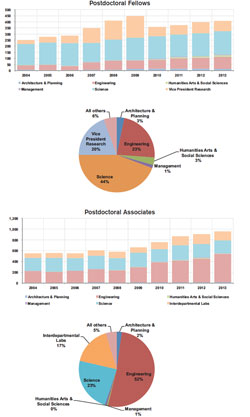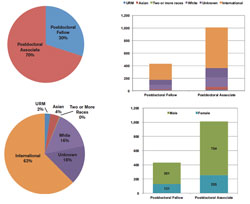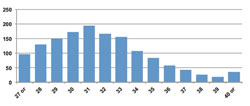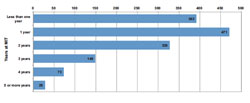
| Vol.
XXVI No.
2 November / December 2013 |
| contents |
| Printable Version |
The Status of MIT's Postdoctoral Researchers
Introduction
In many fields students who complete the PhD take up a postdoctoral position. This has been common for decades in most areas of science, and is becoming increasingly common in engineering. A postdoctoral position allows a researcher to devote full attention to developing research skills, accruing additional publications, and becoming more competitive in the job market. It is often a time for deepening or broadening one’s dissertation research or moving in new research directions.
The MIT postdoc population is extremely important, as postdocs perform much of the groundbreaking research at the Institute and are critical members of research groups, working closely with faculty, graduate students and often undergraduates.
However, this is also a trainee population, on an educational path for one of many possible future careers. Since postdocs do not receive a degree from MIT, it has been important to define this trainee status and associated implications. As stated at web.mit.edu/mitpostdocs/advisory.html
“The postdoctoral training period at MIT is part of the education of a researcher in STEM and other fields. This notion is in accord with MIT policy stating ‘Postdoctoral associates come to MIT to develop their scholarly competence, working under the supervision of MIT faculty members.’ While no degree is offered, this period is nonetheless integral to preparation for a future independent research career. Thus, a postdoctoral scholar is not invited to join a group at MIT simply to perform a specific research project, rather, a broad training program should be in place.”
Postdocs may enter academia, but many will find future employment in non-academic arenas, and career preparation and guidance can help postdocs identify the appropriate path for them. A key challenge has been to address salary and benefits which may vary across the population dependent on mechanism of support and field. Postdoctoral affairs have oversight of the Vice President for Research (VPR). Over the past few years, issues of interest to MIT postdocs have been addressed by the VPR’s Office of Postdoctoral Affairs, in conjunction with the newly formed MIT Postdoctoral Association (PDA). Here, we discuss the present status of postdocs at MIT, highlighting positive changes and discussing some remaining challenges.
Who is a postdoc?
There are ~1,400 postdoctoral researchers at MIT. While the number of Science postdocs has remained relatively constant over the past decade, the number of Engineering postdocs has more than doubled in this same period (Figure 1). The stipend of “Postdoctoral Fellows” is paid from a sponsored award or private foundation but the majority are “Postdoctoral Associates” (Figure 1) where salary is paid from the advisor’s research grant.

(click on image to enlarge)
MIT postdocs form a complex population, with more than 60% international and 27% women (Figure 2). Postdocs are typically in their late 20s and early 30s (Figure 3) reflecting extensive earlier education. Unlike the graduate training period, postdocs spend a variable time at MIT. The great majority stays for two or fewer years although the period can extend to five or more years (Figure 4), especially in the Life Sciences, where experiments can be lengthy and employment opportunities are competitive. However, the postdoctoral training period is not intended for long-term appointments, and extends for four years, but in special cases may be extended to a fifth year with Senior Officer approval. Extensions past the fifth year are no longer granted.

(click on image to enlarge)

(click on image to enlarge)
| Back to top |
Meeting challenges faced by the postdoc population
A 2011 Postdoctoral Life Survey demonstrated significant satisfaction amongst MIT postdocs, but also uncovered opportunities for improvement in the postdoctoral experience. These fell into two broad categories: training and personal resources. Many of these have been addressed by the former and present VPRs. Following the survey, the MIT Postdoctoral Association was launched by the postdocs, and this group has prioritized remaining opportunities for improving the postdoctoral experience. A Faculty Postdoc Advisory Committee was set up in 2012 with the goal “to advise the VPR and the PDA on issues relevant to the training of MIT postdoctoral researchers.”
Improving postdoc training
Having invested heavily in research training, members of the postdoc population are at a crucial point in the career trajectory. Each is deciding whether to follow a research track in the future and if so, whether to apply his/her skills to academic or non-academic paths, or whether to go down a different path. These considerations underscore the importance of mentorship and career planning during postdoctoral training.
To take the trainee status of postdocs into account, the postdoc and faculty advisor are now requested to define training goals for each new postdoc. A formal training plan is required as part of a postdoc fellowship application to Federal and many private funding agencies, and guidance for writing such a plan is provided on the VPR Website. Annual performance reviews for postdocs have been in place at MIT for several years, and serve as an important mechanism to guide postdoc trajectory. Suggested simple review forms are available online. This review (typically 30 minutes) helps determine whether the goals of a postdoc seem realistic and also benefits the faculty advisor, who obtains a record of postdoc performance and assessment.
The short time that most postdocs are at MIT and the local appointment of a postdoc to a research group rather than centrally to a department or unit can make it challenging for postdocs to feel part of the Institute, and to have a “voice” in Institute affairs. The recently formed MIT Postdoctoral Association advocates for postdocs, builds community, offers travel grants and career workshops. Through efforts of the VPR and PDA, postdocs are now represented on multiple MIT committees. Some departments have specific postdoc representatives who may be faculty or staff members, coordinating career information and other activities.
Postdocs follow a multitude of important career paths. Many will enter academia as new professors, but many will not due to personal interests or the number of openings relative to the postdoc population.
Many will enter the private sector, for example in energy, computational, biotech, or pharmaceutical industries, others will be entrepreneurs in “startup” companies, or will enter consulting, financial, or management professions. International postdocs frequently return to their home countries to make use of the excellent skills learned at MIT. Many postdocs become teachers anywhere from “K-20”.
Interesting opportunities are emerging since online education and MOOCs require highly skilled production and teaching staff. Postdocs note that many departments do not offer teaching experience. In the Biology Department, six unit seminars offer specialized material to small groups of upperclassmen and valuable teaching experience to postdoc instructors. Adding similar teaching opportunities in departments where this is not typical seems feasible, depending on salary constraints and support of the advisor. One idea under discussion is whether to offer postdocs the opportunity to obtain K-12 teacher certification, as is offered for students (education.mit.edu/classes/overview). A non-research-based funding source would be necessary for the time devoted to this training.
If postdocs are to be properly guided along this diversity of career paths, detailed career information and networking opportunities are needed. In some fields faculty members do not have the expertise to guide a postdoc in his/her group into non-academic career tracks. In response to this need, many workshops and seminars are organized by the VPR office, the PDA, Schools and departments, and by neighboring universities and organizations. A postdoc can join one or more mailing lists to tap into this information stream. To further assist in professional development at MIT and beyond, MIT postdocs now have access to Career Office services, and to the Writing Center. The VPR sponsors postdocs to participate in the “Path of Professorship” workshop run by the Office of the Dean for Graduate Education. As fits the extensive experience of postdoctoral trainees, it is expected that the postdoc will take a very active role in considering career paths and in accessing and acting on relevant information. Postdocs have recently been able to obtain Associate Alumni status, acknowledging their membership in the MIT academic community and allowing access to alumni networks.
Personal resources
There have been two major concerns with regard to compensation and benefits of postdocs. The first has been to ensure that all postdocs are paid a minimum salary commensurate with their level of education. This has been strongly encouraged by the VPR on the NIH pay scale with the commitment that this salary increases yearly. Most MIT postdocs are now appropriately compensated.
A second concern has been the disparity in benefits between Fellows and Associates. Associates are categorized by IRS regulations as employees with attendant benefits, and Fellows are not. Thus, despite the prestige of being awarded a postdoctoral fellowship, health care and other benefits are not automatically paid. Support for Fellows does not contribute to the MIT benefit pool for the range of support and services that are included in support for Postdoctoral Associates. Recent communication from the VPR has recommended that faculty compensate Fellows to allow equitable health insurance benefits relative to Associates. Gym membership, previously more costly to Fellows, has now been equalized, a popular move as evident in a membership jump. Retirement benefits remain open to Associates only. Due to fellowship duration, a Postdoctoral Fellow may later become an Associate and vice versa, requiring careful bookkeeping.
The postdoctoral period occurs at a time when postdocs may be starting families, adding financial, organizational and, for women, biological challenges. Support for childcare subsidies is another desire by the postdoc community. For female postdocs bearing children, FMLA grants an eight-week maternity leave that has been extended to three months in some groups and departments. We would recommend this duration across the Institute for Associates and Fellows, when fellowship terms permit.
For the future
The efforts over the past several years have improved both the training and compensation of postdoctoral researchers at MIT. Together, these efforts acknowledge the important mission of the Institute in the postdoctoral training period. They also acknowledge the pivotal role that postdocs play in research success at MIT, and the ways MIT postdoctoral training is used around the world to good effect. Challenges remain for the future, but mechanisms and commitment are in place to ensure that MIT remains a premier institute for postdoctoral training and outcome.
| Back to top | |
| Send your comments |
| home this issue archives editorial board contact us faculty website |
